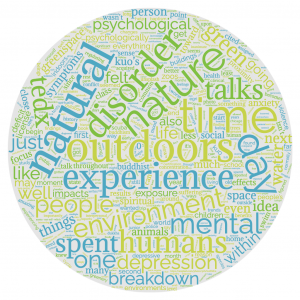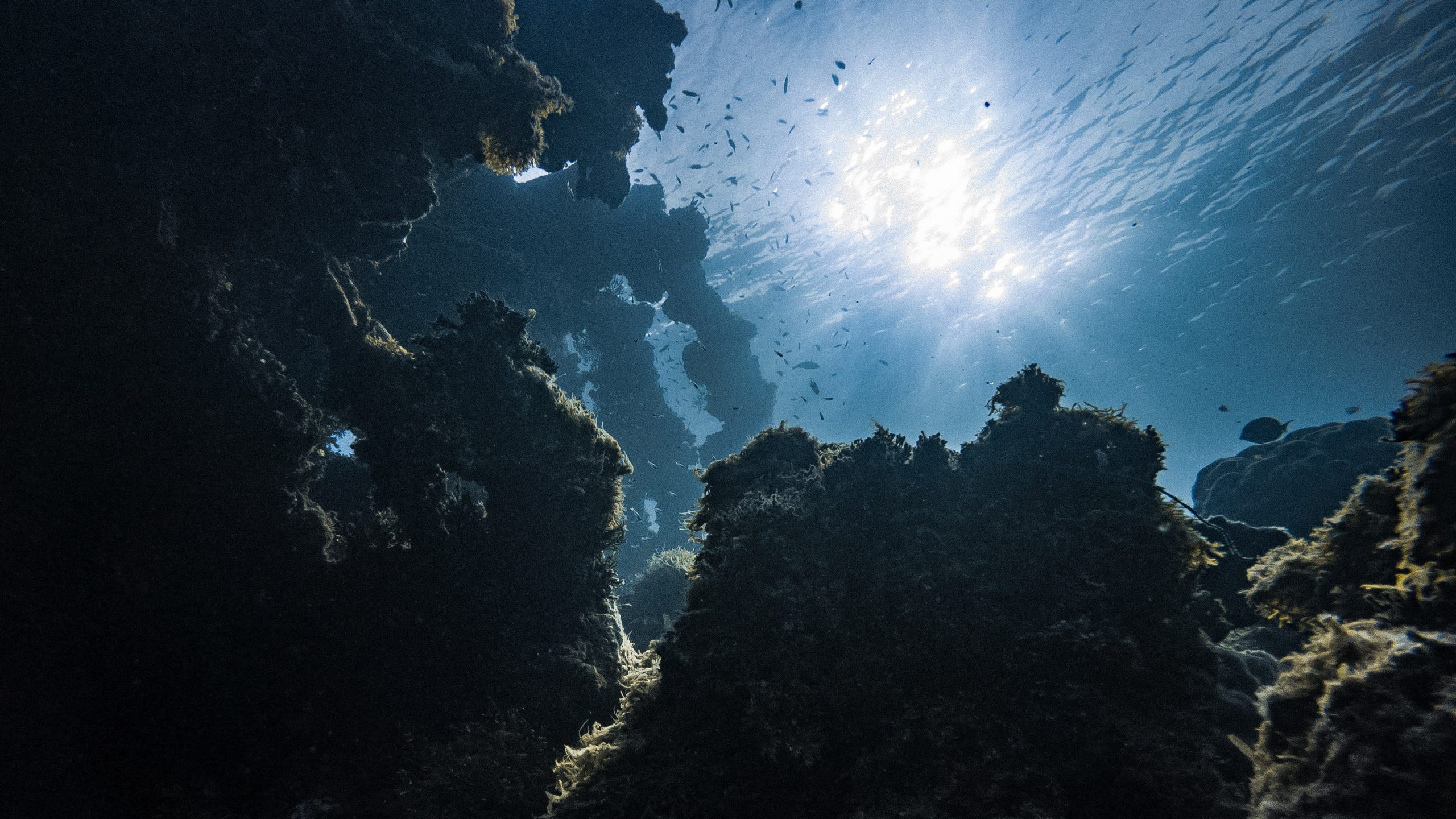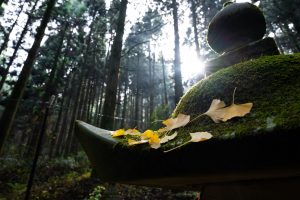29 Humans as Part of Nature: The Benefits of Time Spent Outdoors for Mental Health
Britton Jennings
Hi! My name is Britton Jennings. The core of this chapter’s content came from an experience that I had in high school outdoors that heavily impacted my mental health and the way that I viewed spirituality and nature. Before reading further, I want to warn you the reader that this chapter contains mention and elaboration of depression, so if that’s something that you aren’t in a space to handle you may want to continue past this chapter…read more.

In the summer of 2019, I was a high-school junior going to be a senior the coming year, going on a SCUBA trip out of state with my specialized environmental science class so that I could finish up my certification. This time in life at the end of high school but before college is widely regarded as the most fun and free time for a young person. A time where you’re so close to the end of the life that your parents and the state have laid out for you and still far from the stresses of choosing for yourself in life and dealing with the repercussions of those choices. This expectation was far from where I was at that point in my life.
To open, I’ve struggled with major depressive disorder and anxiety throughout my life since I was old enough to be conscious. My mental state has fluctuated through my life as things have gotten worse and gotten better, sometimes the mental state reacts proportionately to changes, and sometimes it doesn’t. After my junior year of high school, I made some questionable interpersonal choices and as a result, I lost my close friend of twelve years turned partner turned ex-partner, I lost a friend group, and my mom had just relapsed. I spent a good portion of my school day junior year surrounded by students at a different school than my regular one because I was doing a program that allowed for career-based specialization. At that school, most if not all of the kids in my class disliked me or held some shade of disdain toward me. This program was two years long, so I knew that senior year I would have to sit in a class again for multiple hours a day every day surrounded by people that would rather I wasn’t there and weren’t too shy to remind me of it.
By this point in the summer after junior year, I was beaten down and on the verge of not being there to return to school for the second year of that program if you catch my drift. I had had mental health crises before this but none were so long-lasting and so steady. Imagine a grid representing one’s mental health. To start on the grid, when I wake up normally, I start at a 0. Baseline mood, no amazing emotions but also no dangerous thoughts. During the month of my life preceding the SCUBA trip, I would wake up at a point and throughout my day going exponential toward night my mental health would worsen. For the grid example, I’d start my first day at 0 and through the day I would get closer to -1. Normally then, the next day one should start at 0 again as it’s a new day, but during this crisis, I would start that next day at -1 and it would continue that way for the rest of the month. By the end of the month, I was convinced that the only thing that lied ahead of me in life was more regret, more suffering, more pain, no satisfaction, and no rest. I was convinced that I was at fault for everything that had happened to go wrong in my life, I was the reason all my friends left me and I was the reason that I no longer had a lifelong friend. I was the reason I felt so awful and I was the reason things kept going wrong. The worst part wasn’t just that I believed these things, but that I believed I deserved how I felt for what I had done. I had been planning on ending things but I figured that I at least wanted to finish my SCUBA certification because I didn’t want to leave it unfinished.
The day of leaving Ohio and loading into my classmate’s car I was being down on myself as usual and I decided that I wanted to get a second opinion from someone who wasn’t socially expected to tell me that I’m a good person and not at fault, so I prayed. I had prayed before, having been raised Christian, but never with such sincerity or desperation as my life was hanging in the balance. Once we had gotten to the hotel we were staying at, I found out I was rooming with one of the guys in the class who seemed to hate me the most. I figured that it was just a continuation of a lifelong pattern of unfortunate situations but it turned out to be an important moment.
That night I slept and again I woke up worse for wear but that’s where the cycle of mental degradation seemed to stop. I went out that day with the rest of my class to get our certifications to Mermet Springs, an old rock quarry in Illinois that got filled with water and a bunch of props from movies and turned into a diving location. On the first day, I had fun for the first time in a month at least. I got to focus on something entirely detached from my sad life at home. I got to be outside for a full day learning how to properly use the apparatus, I got to swim for hours, interact with and pet fish, and I think most importantly I got to spend time in a serene outdoor environment surrounded by fish, massive trees, and my classmates that were acting surprisingly kind to me, even inviting me out to dinner and to swim with them in the hotel pool after that day’s certification work. Even the guy I was rooming with was being nice to me and asking my opinion on things on tv. That night, I went to bed actually feeling better than the day before and finally ending or at least taking a break from the month-long cycle that had been wearing me out so heavily.
The next day was much the same as the first but something incredible happened. Toward the end of that day’s session in the water, we as a class were allowed to dive on our own and do whatever we wanted within the water. We had finished what was required of us for our certifications so we could just swim and float and even dive if we wanted. I realized that the training was over and we would be leaving soon, so I wanted to just take it all in and appreciate it. The physical sensation of all of my muscles relaxing as I floated, the lukewarm water around my body, the warm sun on my face, and the view of everything before me. I sat on the surface for a good ten minutes and felt this pit in my stomach wash away. All of the guilt for people I had hurt, all of the regrets, all of the anger, all of the frustration, all of the certainty that life held nothing for me but more pain, gone in what felt like a baptism. I still carried the memories but I knew that I was human and could make mistakes and that I needed to forgive myself, and in that moment I was able to. I had never and still have yet to feel anything like it. After that, my entire demeanor seemed to change. I felt hopeful and more importantly content for the first time in what felt like years. The next day for the first time in months, I felt better than the day before.

That experience for me seemed so unique, something that was truly a prayer answered, and it very well may have been, but as it turns out that connection that I shared with the people, fish, trees, and water around me in that moment of emotional baptism has been written about on a much larger scale, as have the emotional, spiritual, and psychological impacts of time spent existing in and with nature.
In Buddhism, there is a belief that to be alive is to suffer. This suffering is referred to as dukkha, and ridding oneself of this dis-ease is a main focus of Buddhism. In David Loy’s (2010) article Healing Ecology, he writes that:
The Four Noble (or ennobling) Truths of the Buddha are all about dukkha and how to end it. To put an end to my dukkha, however, I need to experience anatta–not-self–which from the other side is also my interdependence with all other beings, both living and inanimate. (p.254)
While not a Buddhist myself, my experience out on the water certainly feels like a small version of anatta and certainly relieved much of the suffering that I was feeling. At that moment I felt a connection to everything around me in the water and on land, even with my classmates. The month prior to this experience I had been mostly self-centered as in I was constantly wrapped up in how I felt, how much I regretted everything, and how isolated I felt from everything and everyone. Buddhism, specifically the teaching of anatta, “denies our separation from other people and, yes, from the (rest of) the natural world” (Loy, 2010, p. 255). After that moment and for months after I felt a shift in my attitude. I felt more empathy for plants and animals and even inanimate parts of the natural world such as the dirt and ground below me. I began to spend more time outdoors, and my mood and mental health continued to improve for the next several months. In that moment I believe I truly experienced a lesser form of anatta and I don’t believe it would have occurred had I been doing that same activity somewhere less natural like a pool or something of the sort. There was something about that time spent outdoors that seemed to heal me both spiritually and psychologically.
Outside of Buddhism, the concept of being out in nature as a spiritual experience is common throughout history. In Carolyn Egri’s (1997) article Spiritual Connections with the Natural Environment: Pathways for Global Change, she writes about how nature has played various roles for humanity throughout our development, many of which have been spiritual in nature. The Buddhist idea of there being no true divide between the individual, humanity, and the natural world is echoed throughout other cultures as Egri states:
Nature-centred spiritualities have existed since before the advent of modern human civilization. Although the early Greek and Roman deities have been relegated to the status of mythology, the reverence for nature-based entities or deities remains in many spiritual traditions. … In this holistic and integrative tradition, ‘spirituality . . . pervades and infuses all forms of existence– human, animate and inanimate’ (as cited in Frost & Egri, 1994, p.7). It informs the view that all that exists in nature is living and sacred (as cited in Halifax, 1990; Merchant, 1992). (p. 411)

Egri goes on to say that denying that everything is interconnected and trying to isolate oneself from the greater natural world is destructive to the self (Egri 1997). In my situation, I was very focused upon myself and I viewed myself and my surroundings as fully separate and I felt that self-destruction. The experience I had in nature reminded me of that interconnectedness and I began to experience lessened symptoms of depression and anxiety that lasted for long after.
While spirituality being tied to nature seems to be a simple enough concept to grasp and accept, a non-spiritual person may begin to ponder the question of why time spent in the outdoors has such a profound effect on people and why that seems to be consistent throughout history. To that non-spiritual person, I would say that time spent outdoors not only has a history of spiritual significance but also actually has measurable quantifiable impacts on people’s psychological and social wellbeing.

In Professor Ming Kuo’s (2016) Ted Talk “Vitamin N,” she explains that the majority of humans are suffering from a lack of time spent outdoors, or as she calls it, “nature-deficit disorder” (TEDx Talks, 2016, 0:34). This disorder is caused by the tendency for humans to remain indoors most of the time rather than being outdoors. This tendency isn’t without reason as indoors is where most things go on and the basics of day-to-day life occur for modern humans so it makes sense that we would spend our time that way. Kuo brings up the fact that this predominantly indoors way of life is very new for humans on an evolutionary timescale, and that as a species we haven’t adapted to this lifestyle yet (TEDx Talks, 2016). Most animals other than some species that have been domesticated through history have also spent most if not all time outdoors. This is not the case though for animals within zoos. For those animals that are in zoos instead of outdoors, one may notice that the enclosures tend to resemble the natural habitat of that animal. This was not always the case as enclosures in the early days of zoos used to just be a steel cage within a cart. Kuo explains that the animals kept within these unnatural conditions in the early days of zoos typically had much shorter lifespans than in nature as well as experiencing, “‘social, psychological, and physical breakdown’ as cited by all zoos ever” (TEDx Talks, 2016, 5:43). It would make sense then that the tendency for animals to experience this breakdown when out of their natural environment would extend to humans as well, which is one of the main points of Kuo’s talk.
Backing up the idea of exposure to greenspace being beneficial to humans are crime statistics from the Chicago police department as well as results from questionnaires sent to people living within Chicago public housing. Within this housing, “you have lots and lots of architecturally-identical buildings. Some of them have a little greenery around them, some of them have less. Most importantly, people are randomly assigned through sheer chance” (TEDx Talks, 2016, 6:54). This random assignment of residents to residences gets rid of any significant trends in the people who get assigned to the buildings with more or less exposure to a pseudo-natural environment. When asked, people that live within the buildings that have more exposure to nature in the way of having more trees and the like outside, reported more positive ways of dealing with conflict when compared to those that live in the buildings with less exposure (TEDx Talks, 2016). This data alone stands as a testament to the mental impacts of being exposed to nature and the outdoors even if it’s only through the window or when going in and out of one’s home. Kuo’s research then looked at the police reports in this area and the trends of crime reported in and near those buildings and she says that, “lo and behold, we found in Chicago’s police crime reports, we find the exact same pattern. The greener buildings had fewer violent crimes. That finding has now been replicated in many places with many populations,”(TEDx Talks, 2016, 8:22). From these results, it becomes clear that being in an environment that at least slightly resembles humans’ natural environment aids in stress management and seems to reliably lead to better conflict resolution and a lowered frequency of violence.
The results that Kuo found seem to match directly with the findings of the zoos in that while living in environments that don’t resemble the natural environment of the animal or in Kuo’s case humans, the beings begin to undergo that social breakdown. For humans, it’s fairly clear that nature deficit disorder manifests in worse interpersonal conflict and an increase in violence. Unfortunately, the trends for humans experiencing this disorder also follow another of the zoo’s findings as that violence can oftentimes lead to a decrease in lifespan for those in that environment. Studies into this trend of human behavior changes based on proximity and exposure to greenspace have expanded after these findings, delving deeper into that concept of social breakdown, exploring the effects of the lack of green space on people’s feelings of trust, altruism, generosity, and being safe. The results all seem to indicate that those who live in close proximity to green space experience those feelings stronger whereas those who do not live in close proximity to green space experience lower levels of those feelings on average (TEDx Talks, 2016).
Kuo’s talk goes further than just the social impacts though. Since humans seem to experience similar social breakdown to animals when kept in environments not resembling their natural environment, one may assume that they would also undergo a psychological breakdown which is exactly what Kuo’s talk tackles next.

For the psychological breakdown, they examined the effects of time spent outdoors and in natural spaces on children with attention-deficit / hyperactivity disorder, also known as ADHD. This disorder is one of the most common mental disorders impacting children as 8.4% of children are diagnosed with it (Parekh, 2017). It manifests in children in multiple ways depending on the specific type but generally involves issues including but not limited to: having trouble regulating attention, regulating impulses, memory problems, and problems with organization (Parekh, 2017). The testing involved taking the children to various environments with different levels of greenspace for twenty minutes at a time one day per week over several weeks. Then, after each twenty-minute span, the children’s concentration would be tested. The researchers found that the children reliably performed much better on these concentration tests after being in the environment with a substantial amount of green space when compared to baseline levels of concentration as well as after the time spent in areas with less green space (TEDx Talks, 2016). The scale of the difference in performance according to Kuo was, “the same size as the peak effect for methylphenidate also known as Ritalin” (TEDx Talks, 2016, 10:18). The results from these tests on their own speak to the effects of time outdoors and how that may lead to a sense of peace and spirituality when outdoors or after significant time spent outdoors but when combined with the results from the Chicago public housing and police reports the restorative effects of being outdoors become even more prominent.
A boon to conflict resolution and short-term help for people’s symptoms of ADHD alone is an amazing benefit but Kuo’s talk takes it a step further going on to expand the study to the effects of the second most common mental disorder, depression. According to the American Psychiatric Association, depression, or major depressive disorder as it’s formally called, is a common disorder affecting roughly one in fifteen adults (Torres, 2020). It impacts general mood, mood stability, sense of self-worth, concentration, quality and quantity of sleep, appetite, and general satisfaction overall (Torres, 2020). The study that Kuo references claims that one can predict the severity of depressive symptoms in people without clinical depression and the level of depression in people diagnosed with clinical depression based on the level of green space around their neighborhood (TEDx Talks, 2016). In Kuo’s words, “you can predict the rate of clinical depression in the population: more green, less depressive signs, less clinical depression” (TEDx Talks, 2016, 11:51). This finding was corroborated by the fact that in neighborhoods with more green space, pharmacies in those neighborhoods reported fewer prescriptions for mood-related medication (TEDx Talks, 2016). It seems that ADHD isn’t the only mental disorder whose impacts can be lessened through exposure to greenspace.
After finding all of these impacts of being outdoors, it becomes increasingly clear that much like animals, we as humans require our habitat to be at least somewhat similar to our natural environment or else we begin to experience that social and psychological breakdown much like animals did in the early days of zoos. It’s also increasingly plain to see from Kuo’s talk that the more greenery we surround ourselves with, the less we experience this nature deficit disorder and its ill effects. Even if our homes aren’t the same as our ancestors and our exposure and interaction with the natural world isn’t as much, even just having a bit of green space outside of the house or somewhere that you would come into contact with on a semi-regular basis can have significant impacts on how you feel socially and psychologically. When combining the benefits of even slight contact and the wonders that exposure to nature does for the average person with the effects that it has on symptoms of two of the most common mental illnesses paints a very interesting picture of our relationship with the outdoors and nature. It would make sense that even if there were no spiritual elements and strictly social and psychological benefits, we would view the outdoors as a place of healing for the spirit and mind. These findings, while not exactly what Buddhists are getting at, is a great example of how our isolation from the greater natural world is absolutely and quantifiably harmful to the self both psychologically and socially.
When in the context of my experience on that SCUBA trip, I can absolutely see that I was suffering from nature deficit disorder and that the time spent outdoors in that pristine space was unintentionally just what I had needed to help with my extreme symptoms of depression as well as my anxiety, though the impacts of natural spaces on anxiety were not discussed by Kuo. My interpersonal conflicts with my classmates were resolved and I felt a greater sense of trust and community with my class. I have no idea whether or not my experience washing off the guilt and sadness and everything else that comes with major depressive disorder during that trip was due to some divine intervention, the Buddhist idea of unity with nature, or simply neurochemistry from being in a natural environment, but I do know that had I not been in that beautiful outdoor space that I would still be in a significantly worse state spiritually, psychologically, and socially.
Further Reading
Richard Louv’s Last Child in the Woods: This book is the first to bring up the idea of a nature deficit disorder, and Louv goes into detail about this condition and relates it to rising trends toward obesity and mental disorders in children. He also writes on practical solutions and ways of starting this conversation with others.
Richard Louv’s The Nature Principle: As the sequel to Last Child in the Woods, Louv continues the conversation started in the first book and expands upon it. This book is split into several parts, each with its own focus but still building on the idea of the need for humans to be exposed to nature. The focus of these parts ranges from city planning and community building to health benefits and neurological benefits.
Kenneth Kraft and Stephanie Kaza’s Dharma Rain: This book contains classic Buddhist texts that expand on the Buddhist belief of all life being connected and one, as well as interpretations of those texts. It also includes ways of combining meditation and environmentalism, as well as analysis of Buddhist thought and essays detailing Buddhist action relating to helping preserve natural spaces that are under threat.
References
Egri, C. P. (1997). Spiritual connections with the natural environment: Pathways for Global Change – Carolyn P. Egri, 1997. SAGE Journals. Retrieved December 4, 2021, from https://journals.sagepub.com/doi/abs/10.1177/192181069701000405.
Loy, D. (2010). Healing Ecology. Journal of Buddhist Ethics. Retrieved December 3, 2021, from https://blogs.dickinson.edu/buddhistethics/files/2010/05/Loy-Healing-Ecology1.pdf.
Parekh, R. (2017, July). What is ADHD? Retrieved December 3, 2021, from https://www.psychiatry.org/patients-families/adhd/what-is-adhd.
TEDx Talks. (2016). Vitamin N | Ming Kuo | TEDxDirigo. Youtube. Retrieved November 11, 2021, from https://www.youtube.com/watch?v=JGh8CqS4HLk&ab_channel=TEDxTalks.
Torres, F. (2020). What Is Depression? What is depression? Retrieved December 4, 2021, from https://www.psychiatry.org/patients-families/depression/what-is-depression.
